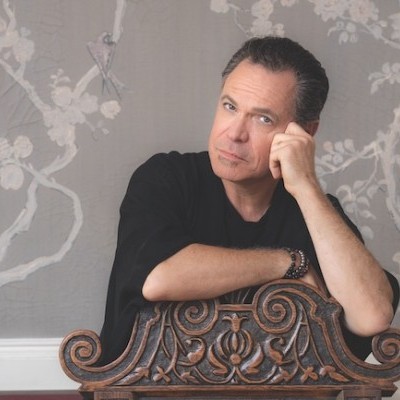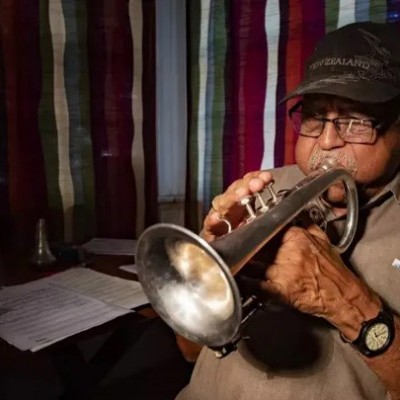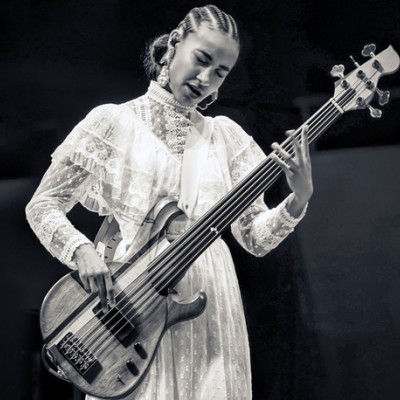Oct 28, 2025 10:47 AM
In Memoriam: Jack DeJohnette, 1942–2025
Jack DeJohnette, a bold and resourceful drummer and NEA Jazz Master who forged a unique vocabulary on the kit over his…

Guitarist Lionel Loueke says he’s frequently struck by inspiration while flying. He doesn’t know why.
(Photo: Craig Lovell/Monterey Jazz Festival)Lionel Loueke is a world-renowned guitarist who has forged a reputation for a unique fusion of music, comprising sounds he encountered growing up in Benin, as well as American jazz. Such was his reputation that his debut album for Blue Note in 2008, Karibu, included input from Wayne Shorter and Herbie Hancock.
More recently, the guitarist has worked with Chick Corea, pianist Kevin Hays and the Luboš Soukup Quartet.
The following has been edited for length and clarity.
Your interest in music began with percussion. Has that interest fed your composition and playing?
Oh, yes, without a doubt. I often think that I am less of a guitarist than a frustrated percussionist who plays guitar. I think percussion is linked to any form of music—that cannot be avoided. And I think that in my own situation, my feeling for percussion influences the timings of my compositions and the techniques I use to play the guitar.
I wish I could explain it properly, but I just think it is instinctive, and it does not really fall into a simple way of defining the effects.
I understand that when you first learned to play guitar, you used bicycle brake cables as strings, which takes some imagination.
It’s simply a matter of necessity. If you can’t afford to buy proper guitar strings—and I couldn’t when I started learning to play the guitar—then you look around for something that will do the job—not well, but better than nothing.
I found that I had to strip all the plastic covering off the cable and find the straight section in the middle which was the best part to use as a string, and then string my guitar with these cables and see what sound I could get out of them. I do not recommend this as a way to learn the guitar; these cables are absolutely no good for the guitar at all; I destroyed the neck of my guitar. I had to take it to the local carpenter to get it repaired. There was no local luthier for me to go to for help, so the carpenter had a look. I told him how to fix the neck, and between us, we managed to get a repair that worked.
If these are your choices, then you work with them. The only way to get proper strings was to find someone who was visiting Nigeria, which was over the border from Benin, where I lived. The problem was, even when I could get proper guitar strings from Nigeria, they were cheap import strings. So, they were not a massive improvement on my brake cable strings.
George Benson was a major influence on you. What was it about his music that you appreciated?
In the 1970s, when George Benson first started to become popular, he was playing a largely r&b style of guitar, which I really enjoyed listening to a lot. The other major thing for me was his technique, the way he composed and played his particular style of guitar music.
I had grown up listening to the African style of guitar, and that was what I was playing. So, to hear someone else play guitar in a completely different way, which is what George Benson was doing, was an absolute revelation to me.
You’ve worked as a sideman for a number of musicians on different projects. They’re after your signature sound. How did you learn to develop that individual approach to guitar?
My honest answer is that I have never really thought about it. I never consciously set out to develop any kind of signature in my playing, something that would be unique to me. I guess I do have it, but it is not from any kind of plan or intention. I have always played what comes naturally to me as a musician, and I think really that anyone who develops a personal sound does the same thing.
Your versatility as a musician seems to be working.
I do enjoy playing different styles of music, and I like to play with different musicians. So, yes, it does suit me—a diversity of projects has been available for me. I like good music, that’s the only constant factor in my playing through my career. I think any producer or bandleader who calls in any player to work on a track is going to want that musician to do what they do, and leave them to play what they think works.
Some musicians write relentlessly and some write specifically for a project. How does it work for you?
I am certainly not someone who can write for a project. Say I am going into the studio in a month: I can’t compose for that month and be ready to go on the start date. That’s pressure to me; I cannot work like that.
I do what a lot of musicians do, which is take advantage of modern technology and carry ideas around on my phone. I find that when I am on a plane, I often get an idea for something. I don’t know why flying gives me inspiration, but it does. So, I will nip into the toilet and hum the bassline or melody line, and then I have it down to keep until I can work it into something.
Do you like to do several takes of a track and choose the best or do you like to use the first one?
When possible, I like to use the first take, the most spontaneous, the freshest version. Anything after that, I am looking to improve on what I just played, which doesn’t always work. But then again, it’s not always about me. Sometimes, we need more takes for the other players to get their best version down.
How far from your recorded versions do you like to go when you are playing live?
I definitely like to explore. I like to go searching, in the studio or on stage. I like the musicians I play with to go searching, as well—to look for the unknown. That is the essence of what jazz music is about. DB

Jack DeJohnette boasted a musical resume that was as long as it was fearsome.
Oct 28, 2025 10:47 AM
Jack DeJohnette, a bold and resourceful drummer and NEA Jazz Master who forged a unique vocabulary on the kit over his…

“Think of all the creative people I’m going to meet and a whole other way of thinking about music and a challenge of singing completely different material than I would have sung otherwise to my highest level in dedication to the moment,” Elling says about his Broadway run.
Sep 9, 2025 1:18 PM
Kurt Elling was back at home in Chicago, grabbing some family time in a late-June window between gigs. Sporting a smile…

Pat Metheny will perform with his Side-Eye III ensemble at Big Ears 2026 in Knoxville, Tennessee, next March.
Sep 9, 2025 12:19 PM
Big Ears has announced the lineup for its 2026 festival, which will take place March 26–29 and include 250…

“[That’s] the thing of the beboppers,” Bradford said. “These guys were important for not only playing that wonderful music, but they knew a sort of social stance, you see?”
Sep 9, 2025 1:07 PM
It was a calm, balmy, near-perfect evening in Westwood, California, not far from UCLA, in the expansive courtyard at…

Esperanza Spalding closed an audacious Chicago Jazz Festival set with “Endangered Species.”
Sep 9, 2025 11:50 AM
The 45th Chicago Jazz Festival kicked off its headline events with two erudite individuals, Esperanza Spalding and…